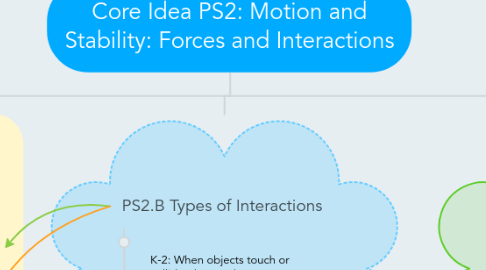Core Idea PS2: Motion and Stability: Forces and Interactions
by Diane Hooper

1. PS2.B Types of Interactions
1.1. K-2: When objects touch or collide, they push on one another and can change motion or shape.
1.2. 3-5: Objects in contact exert forces on each other (friction, elastic pushes and pulls).
1.3. 6-8: Forces that act at a distance involve fields that can be mapped by their relative strength and effect on an object.
1.4. 9-12: Forces at a distance are explained by fields that can transfer energy and can be described in terms of the arrangement and properties of the interacting objects and the distance between them. These forces can be used to describe the relationship between electrical and magnetic fields.
2. PS2.A Forces and Motion
2.1. K-2: Pushes and pulls can have different strengths and directions, and can change the speed or direction of its motion.
2.2. 3-5: The effect of unbalanced forces on an object results in a change of motion. Some forces act through contact, some forces act even when the objects are not in contact,
2.3. 6-8: The role of the mass of an object must be qualitatively accounted for in any change of motion due to application of force.
2.4. 9-12: Newton's 2nd law and the conservation of momentum can be used to predict changes in the motion of macroscopic objects.
3. PS2.C Stability and Instability in Physical Systems
3.1. K-2: Whether an object stays still or moves often depends on the effects of multiple pushes or pulls on it.
3.2. 3-5: A system can change as it moves in one direction, shifts back and forth, or goes through cyclical patterns.
3.3. 6-8: A stable system is one in which any small change results in forces that return the system to its prior state. A system can be changing but have a stable repeating cycle of changes.
3.4. 9-12: Systems can change in unpredictable ways; understanding the forces that drive the transformations and cycles within a system, as well as the forces imposed on the system from the outside, helps predict its behavior under a variety of conditions.


